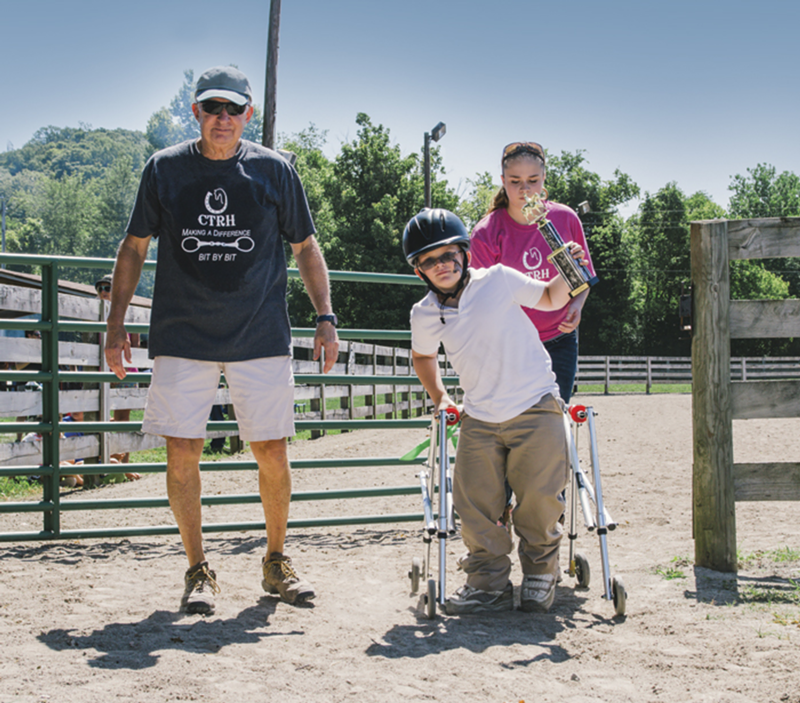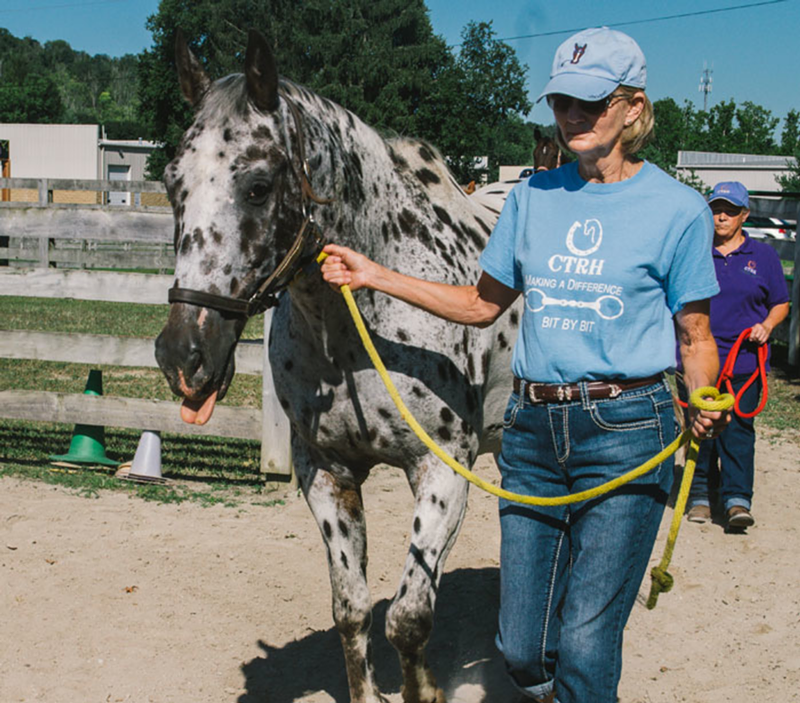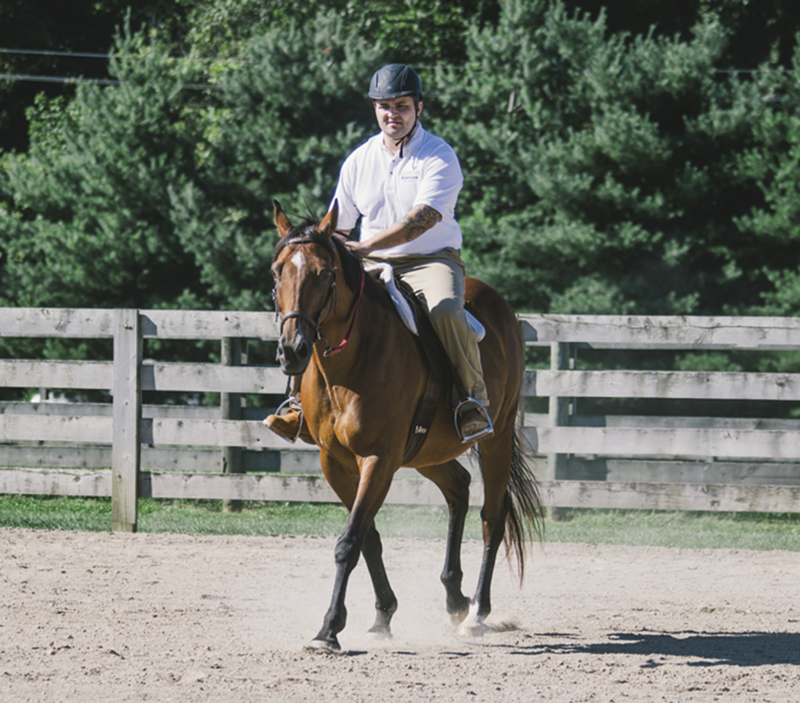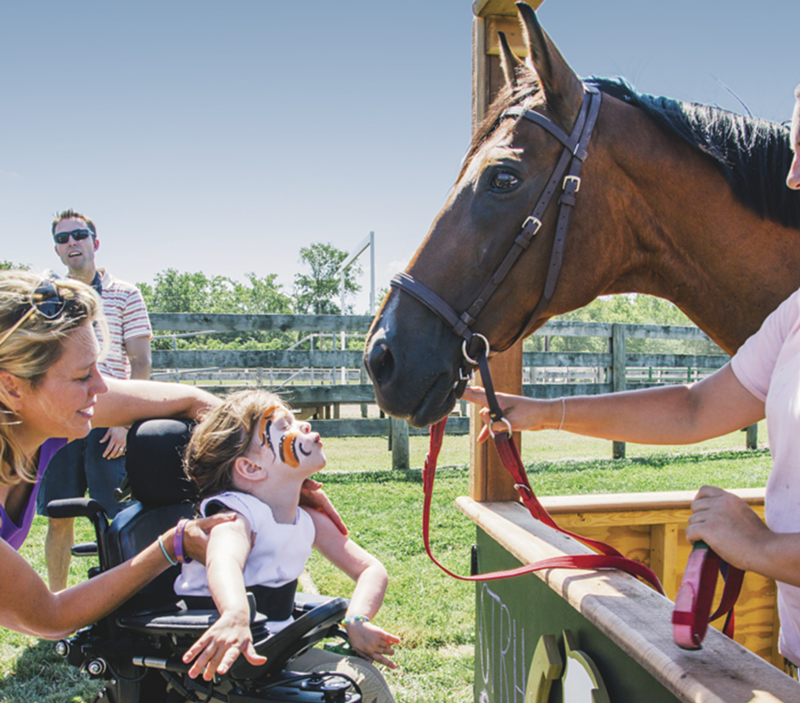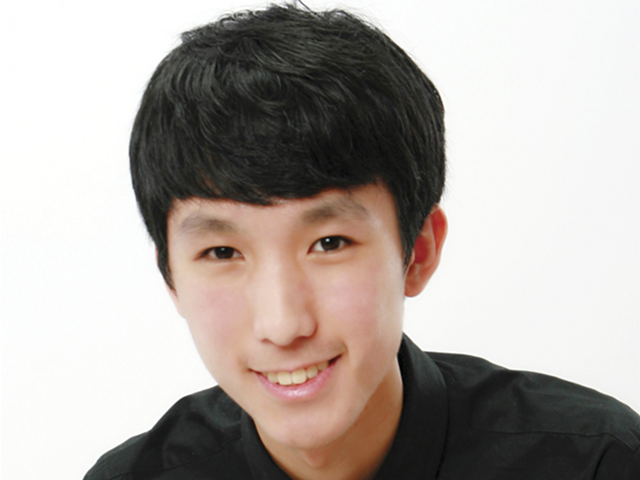
Four-year-old Blake Farrell’s favorite activity at Cincinnati Therapeutic Riding and Horsemanship is riding backward on her horse, either while sitting up or lying down. The exercise helps Blake, who has type-two spinal muscular atrophy, stretch out her back and strengthen her core.
Blake is one of 125 individuals who participate in programs provided by CTRH, a 30-year-old organization that provides horse-related therapies and activities to children and adults with disabilities. Located in Milford just off of U.S. 50, the center encompasses 19 acres of land and a herd of 16 horses. Riders’ disabilities range from Down syndrome, cerebral palsy and autism to visual and hearing impairments, developmental delays and more. It also offers a program for veterans with diagnoses including PTSD.
Blake and 19 other riders showcased what they have been learning Aug. 1 at CTRH’s sixth-annual Richard Thomas Horse Show, named for one of the center’s donors.
“Even if (riding) didn’t help her physically, we would do it anyway because she loves it so much,” says Blake’s father, Nick Farrell, about her participation at the center. Blake waved to her family during the show from the back of a white Welsh pony named Blue, which also happens to be Blake’s nickname because of her blue eyes.
Blake has been riding at CTRH since she was 2, and this year’s horse show was the third in which she has participated. She reflected on her experiences after the show between bites of a purple snow cone, talking about her favorite horse at the center, Penny, and the fact that she enjoys leading horses over poles her instructors sometimes set up on the ground.
“The horses are magic. They just are,” says Linda Ray Rubel, CTRH’s executive director. She adds that each horse must complete a three-month “job interview” that examines everything from temperament to riding capability to make sure the horse is a good fit for the program. “These horses know that their riders have special needs, and they behave accordingly.”
• • •
Children’s positive responses to horses is what led to the establishment of the center in 1985, when stable owner Childress “Chile” Rodgers brought ponies to visit handicapped kids at a local day camp called Stepping Stones. Rodgers was inspired by their reactions to the animals, so she teamed up with Sue Radabaugh, then-day camp director at Stepping Stones, and teacher Bobbi Thies to found Cincinnati Riding for the Handicapped, which evolved into CTRH. Since its first year of operation, the program has grown from only five riders to its current 125.
Today, CTRH owns its own facility, which continues to grow. The nonprofit raises 80 percent of its annual budget through grants, donations and fundraising events like the show on Aug. 1.
All of its buildings are handicap-accessible, and a new indoor arena — a $950,000 project called the Hatton Riding Center — was completed in 2009, enabling the center to remain open year-round. It previously closed in the winter when low temperatures and poor conditions became too severe for riders and horses to be outside. Participation, however, relies on the availability of both riders and volunteers.
CTRH currently offers four different programs: Adaptive Recreational Riding (ARR), group lessons that teach horsemanship in addition to riding skills; Hippotherapy, a type of therapy that utilizes the movement of a horse to address a range of impairments and limitations; Warrior’s Own Road to Horsemanship for veterans with disabilities; and Ground Lessons for riders who cannot be safely mounted. About 75 percent of CTRH’s riders are children under the age of 18, but participants range in age from 2 to 70.
ARR, the center’s original program that currently serves the most participants, is conducted in a group setting and led by an instructor certified by the Professional Association of Therapeutic Horsemanship International (PATH). Becoming certified is a year-long process that measures competency in horsemanship, riding instruction, knowledge of disabilities and more. “That’s why we can guarantee everyone here is safe,” Rubel says. CTRH currently has five PATH-certified instructors, with an additional instructor in training.
ARR sessions generally last one hour. During that time, riders groom and mount their horses, perform exercises on horseback, untack and clean up by putting away saddles and bridles. “It’s a fun time,” Rubel says, adding that each class is a little bit different.
Groups contain between two and five riders depending on the availability of volunteers. There are at least two volunteers to every one rider, and Rubel says help varies depending on the time of year; for example, high school and college students are more likely to volunteer during the summer, and numbers tend to drop off when school begins in the fall.
About 200 volunteers currently work at CTRH, completing 1,500 hours of service annually; these individuals must be at least 14 years old and are required to complete a training program before working alongside the riders. “We get amazing support, but we can always use more,” Rubel says. “And we can always use more volunteers. That’s one of my main mantras right now.”
• • •
Four young riders stretched in the Hatton Riding Center as they prepared to mount their horses in a morning ARR class on July 24. Family members watched from behind ceiling-high windows featuring one-way glass, allowing them to see in but preventing riders from seeing out, which Rubel says limits distractions.
One of the riders mounted with the help of a piece of equipment called a Lift, which raised her out of her wheelchair and lowered her onto her horse. Volunteers stood on either side to help her settle in and take the reins. Another rider mounted a horse named Ruger, who is popular because he has one brown eye and one blue eye. “The kids like that he’s a little different, too,” Rubel says.
The class was instructed by Kit Collins, or, as employees and riders refer to him, “The Polo Guy.” Collins trains polo horses, some of which are ridden as part of CTRH programs while they are groomed for the sport. “These horses have to be bulletproof, and polo horses are often that,” Rubel says.
The center’s herd — currently comprising 16 horses — fluctuates depending on the number of animals in training. The majority of horses are donated to the center, and they are generally both smaller and older; smaller sizes accommodate the needs of riders, while older horses tend to have gentler temperaments.
Not all of CTRH’s horses are active in its programs — Sunny, a blind appaloosa, enjoys a permanent retirement on the property.
“It’s hard to re-home a blind horse, because they need to know their surroundings,” Linda says. “We decided to keep him here and raise money for his keep.”
After conducting a few exercises inside the barn, Collins led the group outside on foot, and riders and their horses followed in a single-file line. Two volunteers stood beside each horse, one holding the reins and the other supporting the rider. The remainder of the class took place in the outdoor ring, with riders walking their horses along the perimeter of the arena.
Rubel watched from the shade of an adjacent pavilion alongside Rob Seideman, who is set to take over the position of executive director this month when Rubel retires. The pair was silent for a moment as Collins interacted with the class, and Seideman said a single word as the group entered the ring — “beautiful.” It’s moments like this that have kept Rubel in her position for so many years.
“It was three and a half years ago when they asked me to sit in for six months, and here I am,” Rubel says. “I’ve loved every single thing I’ve done here. It’s been great fun, and I truly believe I was in business for 25 years to learn what I needed to do (to help run CTRH)."
• • •
On the morning of the horse show, Rubel and Seideman stood beside the gravel road that leads into the center. They directed car after car to park in an outdoor pasture next to the outdoor arena, where the show was held. By 10 a.m., the arena’s fence was surrounded by dozens of friends and family members, and riders were discernible by their white dress shirts, khaki pants and black helmets.
The show was opened by 29-year-old Sean Mercado, one of two veterans who participate in the WORTH program, which is geared toward injured veterans and offers both ground and therapeutic lessons. Mercado was introduced to CTRH by his mother, who is a volunteer at the center.
“She found out about this program, and for a while before I started coming here, she said since I got out of the military I’ve changed,” Mercado says. “I’ve kind of withdrawn from everybody and didn’t want to be around people. I just stayed to myself in my own home. The only time I socialized was through video games with a couple of family members.”
One day, his mother asked him to come out and volunteer with her. “Little did I know,” Mercado says, “she had already set it up for me to be in the program.”
His performance in the show was only the 13th time Mercado has been in the saddle, and the event was the first opportunity for his family to see him ride. Instructed by Collins, Mercado rode independently on a polo horse named Juan without the assistance of additional volunteers. He urged Juan into a trot and a brief canter; then, Collins called out letters for Mercado to follow that were posted around the arena — a style of riding called dressage.
“This is amazing,” Mercado said after the show. “Honestly, I’ve got a lot of things going on in my life, as everybody does, that bring me down a lot, and I’m in a very dark place most of the time. This is the one light spot in my week, every week, that I get to come to.”
The WORTH program is one of the main aspects that attracted Seideman to CTRH, and going forward he plans to reach out to as many local veterans as possible in an effort to get more involvement. In fact, before applying to the position of executive director, he was planning to open his own riding organization for veterans. Then he came across CTRH’s website. “Why would I reinvent a program when one already exists?” he says.
“We’re working really hard with a lot of local veterans organizations,” Rubel says. “Unfortunately, most of the veterans have some type of diagnosis. It’s usually anxiety or PTSD. We’re pretty good at handling physical disabilities — we’ve been doing that for a long time. But we’re thinking that, in the future, we’ll probably be partnering with veteran organizations who will be bringing their own mental health professionals with a group of riders.”
Rubel adds that CTRH will only continue to grow. “We’re ready to move to the next level,” she says. “I think Rob’s going to do that for us.”
• • •
As morning turned into afternoon, friends and family members took refuge from the sun under the pavilion and in the shade of a large oak tree. A face-painter disguised children as butterflies, tigers and snakes, and next to the outdoor arena a small brown horse stood in the frame of a station labeled “Pony Kissing Booth” in curly pink letters.
The third group of the day, this one featuring five riders, lined up their horses to face spectators and dismounted with the help of volunteers, prompting a round of applause from the audience. They walked out of the arena to receive a trophy, topped with a golden horse and rider, for their participation in the show.
Over by the barn, Blake, still wearing her white shirt and khakis, sat in her wheelchair surrounded by family members. Her family took turns holding her trophy so she could enjoy her snow cone.
Meanwhile, Rubel and Seideman were in constant motion, hugging riders and their families and introducing themselves to their guests.
“We’re a big family,” Rubel says. “We really are.”
It’s difficult for Rubel to select just one favorite memory from her time at the center. “That’s a hard one. That’s a really hard one,” she says, pausing to think. “For me, it’s when I interact with the kids.”
“There’s a million different levels, but the strongest one for me is when I watch the parents,” Seideman adds. “When I watch the parents watch their kids smile — that opportunity doesn’t come around all that often. Sometimes I’ll just start crying watching the parents start to cry — they’re just crying tears of joy, because their kids are smiling and laughing. And they might not do that any time but here.” ©

